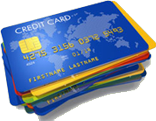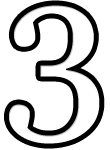 You don't need new cards to slash the interest you pay! Lenders love you to apply for shiny new plastic, but do the 'Credit Card Shuffle' - which moves existing debts to the most efficient place - and you can shimmy up to 70% off the cost with NO NEW CARDS.
You don't need new cards to slash the interest you pay! Lenders love you to apply for shiny new plastic, but do the 'Credit Card Shuffle' - which moves existing debts to the most efficient place - and you can shimmy up to 70% off the cost with NO NEW CARDS.
In this guide
Quick Links:
If you've got a decent credit score and just want to shift debt to a long term 0% deal
Read the Best Balance Transfers guide
TV MONEY MAKEOVER SUCCESS!
This works! In a past TV money makeover I cut a heavily indebted
man's interest from �2,700/yr to �600/yr, WITHOUT new cards.
Please tell us about your Shuffle Successes.
Who's the 'Shuffle' for?
Match up your circumstances against the Shuffle checklist and, if any of the ticks apply to you, the Shuffle could be right up your street...
-
Do you get rejected for new credit?
New customer offers are the cheapest option to cut the cost of debt, but often those most in need of cheaper credit don't get accepted.
However, don't automatically assume you'll fail on application - there are techniques you can try and special cards you can apply for even if you normally struggle to get a yes - read 'Bad Credit' Credit Cards.
-
Do you want to protect your credit score?
Applying for lots of cards, especially in a short space of time, hits your credit score.
The Shuffle can and should be used in conjunction with new cheap debt card applications, as it efficiently uses existing debts and means less cards are needed.
For all the current top deal see the Best Balance Transfers and Best 0% Cards guides. -
Can you always meet at least minimum repayments?
If you consistently can't meet even your minimum outgoings, the Shuffle won't help you.
Instead see one of the free debt help agencies like Citizens Advice or Consumer Credit Counselling Service as soon as possible. See the �Debt Problems: What to do guide for more details.
Watch the video guide
Filmed on 28 April 2011
Courtesy of five TV. Originally from It Pays To Watch! Jan 2009
The Credit Card Shuffle itself
Each step works both independently and in combination. If one doesn't work, don't be disheartened, try them all.
Got more than one credit/store card...? Try all steps
Only got one credit card and an overdraft...? Try steps 1, 3 & 4
Step 1: Ask them to cut the rate 
Sometimes simply calling and asking for an interest rate reduction works. The credit card market is competitive and interest rate matching policies are common. If you've already got a cheaper rate on another existing card, this should help you batter them down.
Call up and say...
I need cheaper debt, but I'd prefer not to leave you
This works regularly, as special customer retention reps often have substantial power to authorise deals. For haggling hints and tips read the full Haggling guide.
 Step 2: Shift debts around existing cards
Step 2: Shift debts around existing cards
Transferring a balance means you move debts to a credit card from another card for a fee of around 3%. For example, if you balance transfer to the Barkercard from the Corbettcard, in practice the Barkercard pays off the Corbettcard for you, so you now owe it the money instead.
The absolute best balance transfer offers used to be preserved for introductory offers for new cardholders, but an increasing number have existing cardholder offers too.
This means expensive debts sitting on a card can be cheaply moved across. A long running example is Barclaycard's existing customer offer, they can shift debts to it at 6.9% (with a one off 2.5% fee) lasting until the entire debt transferred has been paid off (see the Barclaycard loophole guide).
Check your card company's offer before calling.
Some card companies have official set rates, others target individuals, before you make the call it is important to be prepared.
To help we've collated a list of the current offers available, while these will change over time, it gives you an idea of the scale of deal you should expect.
Click to see the big providers' existing customer deals
As the credit card market is competitive and providers want to retain their customers, customer service teams often have substantial power to authorise deals to keep you.
Check this list for possible existing customer deals from your credit card provider. Whilst these offers are not guaranteed for everyone, and they may change over time, you can get an idea of the type of deals on offer. Please let us know any deals you manage to get.
Card | Representative APR | Existing Customer Offer |
|---|---|---|
Barclaycard | 17.9% - 18.9% | Official Response: standard offer of 6.9% for life of balance, with a 2.9% fee. more info |
Capital One |
9.9% - 34.9% | MoneySavers Experiences: 4.9% for life of balance |
First Direct |
16.9% - 19.9% | MoneySavers Experiences: Nothing reported (let us know) |
Halifax |
9.9% - 17.9% |
MoneySavers Experiences: c.6.95% for life of balance OR 0% for 9 months (3% fees on both) |
HSBC |
16.9% |
MoneySavers Experiences: c. 0% for six months (2.9% fee) |
MBNA |
16.7% - 17.9% |
MoneySavers Experiences: 6.9% until repaid (2.98% fee) or c.10 months 0% (3% fee) |
Nationwide |
16.9% | MoneySavers Experiences: Nothing reported (let us know) |
Natwest |
16.9% - 18.9% |
MoneySavers Experiences: standard offer of 0% for c. 9 months, 3% fee |
Post Office |
16.9% |
MoneySavers Experiences: 0% for c.9 months, 2.98% fee |
RBS |
16.9% - 18.9% | MoneySavers Experiences: standard offer of 0% for c.6 months with 3% fee. |
Santander | 17.9% | MoneySavers Experiences: Nothing reported (let us know) |
Tesco |
16.9% |
MoneySavers Experiences: c. 1.9% for 6 months (2.5% fee) or 7.9% until repaid (no fee) |
Virgin |
16.6% - 18.9% |
MoneySavers Experiences: 6.9% until repaid (2.98% fee) or c.9 months 0% (3% fee) |
What you need to do...
Simply call up your card provider and ask the following questions:
What's the cheapest APR you'll give to move debts from other cards?
What is my current outstanding debt?
What is my current credit limit and can you increase it?
Even if there's no special offer rate or increased credit limit, you could still save with step 3. 
Step 3: The Shuffle Itself!
At this point, it�s important to take stock of the situation and note down all your debts in a list. To help we�ve prepared a simple worksheet for you to make it easier.
Note down all your debts in the worksheet, including your overdraft as it's quite possibly more expensive debt than your credit cards.
If you want to factor in personal loans too that�s fine, but be careful as sometimes switching loans to a cheaper interest rate can perversely mean you pay more! Read the Cut the Cost of Existing Loans guide before doing so.
Crucially, also include any new credit you've managed to open, or are considering, so you can work out how to make the debt cheapest; this should free up space to make the shuffle work more effectively. Find the details of the cheapest new card for you in the Best New Balance Transfers article.
Shift the debt to where it�s cheapest
The aim here is to take advantage of the new and existing customer balance transfer offers. This takes a little bit of planning, but the second section of the Credit Card Shuffle Worksheet should help you decide what to do before putting it into action.
Even if special rates aren't available, shift the money to cards with the cheapest standard rate. Just a couple of percent interest drop can make a major difference.
This simple example below should help:
Card Name | Current Interest Rate | Current Debt | Credit Limit | Special Balance Transfer? |
|---|---|---|---|---|
Johncard | 14.9% | �1,500 | �3,000 | none |
Paulcard | 16.9% | �0 | �3,000 | 0% for 6 months |
Georgecard | 19.9% | �500 | �2,000 | None |
Ringocard | 17.9% | �5,000 | �5,000 | None |
At this point the total debt is �7,000 at an average interest rate of 17.4%. The obvious start point is the 0% for 6 months on the Paulcard, and the aim should be to shift the most expensive debts there up to its credit limit. Thus balance transfer the �500 from the Georgecard onto the Paulcard.
There�s then �2,500 left of the Paulcard credit limit, so move the debt from the next most expensive interest rate, the Ringocard. This leaves �2,500 on the Ringocard and while the Johncard doesn�t have a special offer, its standard rate is cheaper than the Ringocard, and with �1,500 left on its credit limit you can shift some more there.
Card Name | Interest Rate | Current Debt | Credit Limit |
|---|---|---|---|
Johncard | 14.9% | �3,000 | �3,000 |
Paulcard | 0% for 6 months then 16.9% | �3,000 | �3,000 |
Georgecard | 19.9% | �0 | �2,000 |
Ringocard | 17.9% | �1,000 | �5,000 |
The average interest rate has nearly halved from 17.4% to just 9% for the first six months, saving �300 in interest over that period. After that, while the rate will increase to an average of just under 16%, the lower interest in the first six months will mean more of the repayments have gone towards reducing the actual debt rather than paying the interest.
Plus there�s nothing stopping you shuffling again at that point to keep things cheap, and it�s perfectly possible another company may then be willing to offer you cheap debt. 
Step 4: Repay most expensive debts first
This is possibly the most crucial part of the entire shuffle. So important in fact, I'm going to shout...
Start repaying, focussing as much cash as possible on the most expensive debt first.
This means you should pay just the minimum repayments on all other, less expensive, cards, and throw all spare cash at the dearest to pay it off. Once it's repaid, shift focus to the next highest rate card and continue this until you're debt free.
This focusing quickly reduces the interest you pay even if none of the other steps work.
Do include your overdrafts though. With an 18% overdraft and 13% credit card, you're better off spending on the card, paying just its minimum monthly repayments, and using all your income to reduce the overdraft, as it's more expensive.
What if you've debts at different rates on one card?
If you balance transfer to a card at a special cheap rate, but already hold pricier debts on it, the provider biases your repayments towards the higher rate debts first. This is good, as it means the most expensive balance disappears first (it used to be the other way around).
However, it means to get the absolute most out of the shuffle, there are a couple of extra steps.
Only focus repayments until the expensive debt's repaid
Once you have done the shuffle, and you know the priority with which you should pay off each lump of debt, ensure you stop once all of the expensive layer is gone.An example will help illustrate this...
Ivor Debt has an Osbornecard with a �3,000 balance at 12.9%, and a Cablecard with a �1,000 at 19.9% and a further �2,000 at 0%.He should first focus on paying off the �1,000 at 19.9% on the Cablecard, but once that's done switch his big repayment to the Osbornecard's 12.9% debt. Then once the �3,000 is fully repaid, focus back on the 0% debt on the Cablecard.
-
Advanced tip - Move existing debts away, then back again.
If you've got enough spare balance on other cards, then you can take full advantage of any special balance transfer deal by moving all the debt off the card, then once it has cleared shift it back again (along with whatever other debt you intended to move to the card). This means as much debt as possible is at your new, lower rate.Though there may be balance transfer fees charged which could wipe out the gain, so be sure to check before you try this. The only danger here is credit card companies do have the right to stop you moving the money back. This rarely happens, but you should be aware.
The Size of the Saving
With normal debts of �3,000 on Angelinacard, �2,000 on BradCard and �1,000 on a store card the average interest rate is 18.5%. Repay �300/month and by the time you've cleared the cards in full the interest totals �1,140.
Yet shuffle as much as possible onto Angelinacard's 6.9% existing customer offer and the rest to BradCard at 12.9% and then repay the most expensive debts first, and the average interest rate is reduced to 7.9%, meaning the interest is only �390, around a third of the cost.
Card | Credit Limit | Pre-Shuffle | Post Shuffle |
Interest Rate | Debt | Total Interest (1) | Interest Rate | Debt | Total Interest(2) | Saving |
|---|---|---|---|---|---|---|---|---|
Cherylcard | �5,000 | 18.9% | �3,000 | �570 | 6.9% | �5,000(3) | �360 | - |
Halifax One | �5,000 | 12.9% | �2,000 | �250 | 12.9% | �1000 | �30 | - |
CowellCard | �2,000 | 29% | �1,000 | �320 | 29.9% | �0 | �0 | - |
TOTAL | Ave rate = 18.5% | �1.140 | Ave rate = 7.9% | �390 | �750 | |||
(1) Debt repaid in proportion to initial balance (2) Repaying most expensive debt prioritised (3) All debt now balance transferred; to do this it was moved off the card and returned | ||||||||










